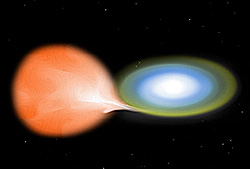Nova
In the vast expanse of the cosmos, there are celestial events that captivate our imagination and provide invaluable insights into the workings of the universe. Among these awe-inspiring phenomena is the enigmatic display of a nova. Nova are transient astronomical events that occur in binary star systems, captivating astronomers and stargazers alike. In this article, we will delve into the fascinating world of novae, exploring their nature, origins, and the captivating celestial fireworks they produce.
What is a Nova?
A nova, derived from the Latin word meaning "new," refers to a sudden, temporary increase in the brightness of a star. Unlike supernovae, which represent the explosive death throes of massive stars, novae occur in binary systems consisting of a white dwarf and a companion star. These systems often involve a compact white dwarf siphoning off matter from its companion, forming an accretion disk around it.
The Process of a Nova
- Accretion of Matter: The white dwarf gradually accumulates matter from its companion star through gravitational attraction. Over time, an accretion disk forms around the white dwarf, composed of gas and dust.
- Critical Mass Reached: As the mass of the accreted material increases, a critical limit, known as the Chandrasekhar limit, is eventually reached. This limit, roughly 1.4 times the mass of the Sun, triggers the cataclysmic event that leads to a nova.
- Thermonuclear Ignition: When the white dwarf's mass surpasses the Chandrasekhar limit, the compressed and heated material in the core reaches a critical temperature, initiating a runaway thermonuclear reaction. This reaction rapidly converts hydrogen-rich material into helium through nuclear fusion.
- Explosive Energy Release: The thermonuclear ignition releases an enormous amount of energy, causing a powerful explosion on the surface of the white dwarf. This explosion ejects the accumulated matter into space at speeds exceeding thousands of kilometers per second.
- Temporary Brightening: The ejected material forms a luminous shell of gas and dust around the white dwarf, significantly increasing its brightness. This surge in luminosity makes the nova visible across vast distances, even to the naked eye on Earth.

The Evolution and Aftermath
Following the initial explosion, the brightness of the nova gradually decreases over a period of weeks or months. However, the event leaves a lasting impact on the binary system. The white dwarf may continue to accrete matter from its companion, potentially leading to recurrent novae if the conditions are met. Over time, the ejected material from the nova disperses into space, enriching the interstellar medium with heavy elements synthesized during the thermonuclear reaction.
Significance and Scientific Value
The study of novae provides valuable insights into various astrophysical processes, including stellar evolution, nucleosynthesis, and the dynamics of binary star systems. Astronomers can analyze the spectra emitted by novae to identify the elements involved in the thermonuclear reactions, shedding light on the composition of the universe.
Moreover, novae play a crucial role in determining the cosmic distance scale, which allows scientists to estimate the distances to other galaxies. By observing recurrent novae in distant galaxies and comparing their intrinsic brightness to their apparent brightness, astronomers can calibrate the relationship between luminosity and distance, helping to measure the vast distances of our universe.
Novae, with their explosive displays of stellar firework, reveal the intricate dance of binary star systems and offer a glimpse into the captivating mechanisms that shape our universe. These transient events not only ignite our sense of wonder but also contribute to our understanding of stellar evolution, nucleosynthesis, and cosmic distances. As astronomers continue to unravel the mysteries of novae, these celestial spectacles will continue to inspire and enlighten us, revealing the profound beauty and complexity of the cosmos.
References
- National Aeronautics and Space Administration (NASA): https://www.nasa.gov/mission_pages/nustar/novae
- The Smithsonian Astrophysical Observatory (SAO): https://www.cfa.harvard.edu/sao-astroexplorer/nova.htm
- Space.com: https://www.space.com/18896-nova-stars.html
- American Association of Variable Star Observers (AAVSO): https://www.aavso.org/nova
- University of California, Berkeley: https://cse.ssl.berkeley.edu/bmendez/ay10/2000/novae/white.html
More From Author
supernova